Social Media Monitoring: A Complete Guide for 2026
Table of contents
There are over 5.24 billion social media users in 2025. And they are posting quite a lot of content. For example, in August, according to Brand24 data, Nike received 248k social media mentions, Spotify 355k, McDonald’s 116k, while iPhone 16 received 63k. Let’s discover what insights you can uncover with social media monitoring.
But before we get started. Why am I actually writing about social media monitoring?
Let me quickly explain.
I have been working for a media monitoring software company since September 2021.
And since then, I have participated in hundreds of meetings focused on product development, customer needs, and the latest monitoring trends.
I have closely watched how our product has evolved and grown. My goal is to give you first-hand knowledge.
What is social media monitoring? Definition
Social media monitoring is the process of tracking and analyzing tagged and untagged mentions across various platforms to understand what people say about a brand, product, competitor, or industry.
In simple words: Social media monitoring, in simple words, means keeping track of what people say about your brand (or any topic) on social media channels.
Furthermore, social media monitoring tools have plenty of analytical features that get you heaps of data and insights about monitored keywords.
So you can draw the right conclusions and implement them into your social media strategy.
It helps you:
- See who mentions your brand
- Know whether people speak positively, negatively, or neutrally
- Catch trends and viral topics early
- Discover what your competitors are doing
- Find influencers for collaborations
- Respond quickly to customers or crises
In 2026, a solid social monitoring software should ensure:
- Tracking mentions: Tracking the key keywords. In business, they could be connected to: brand, product, service, industry, CEO, competitors, marketing campaigns, hashtags, and anything business-related.
- Real-time alerts & engagement: Catching valuable mentions as they happen and replying to customer questions or complaints.
- Analyzing sentiment and emotions: Identifying whether the social media conversations are positive, negative, or neutral to gauge the target audience’s perception and emotions.
- Identifying trends & insights: Spotting emerging topics, viral mentions, or recurring customer pain points to guide marketing, PR, and product strategies.
- Crisis management: Detecting sudden spikes in negative mentions that could signal a PR issue, so a brand can respond quickly and protect its reputation.
- Measuring impact: Tracking reach, engagement, volume of mentions, AVE, and share of voice to measure the effectiveness of campaigns.
Important note: You can monitor only public social media posts and content. The sources of social media mentions depend on which tool you choose.
We are looking for mentions of our brand to prevent crisis situations, to put out fires promptly, and to engage in important conversations regarding our business.
What is AI social media monitoring?
AI social media monitoring is the process of tracking, analyzing, and interpreting mentions and conversations about your brand, competitors, or industry across social platforms, but enhanced with artificial intelligence (AI).
In simple words: Instead of just showing raw numbers (mentions, comments, reactions, reach), AI tools go deeper and provide context, insights, and recommendations.
Social media monitoring vs. listening
At first glance, these two concepts may seem very similar to you. I understood that, before I was hired at Brand24 in 2021, I didn’t see much difference either.
But there’s a difference for sure.
In a nutshell: Monitoring catches individual social conversations in real time. Listening aims to understand the story behind all those conversations.
| Social media monitoring | Social listening |
| Focuses on what people are saying | Focuses on why people are saying it |
| Ractive, focusing on collecting data | Strategic and proactive, aiming to extract insights from that data |
| Real-time tracking of mentions and conversations | Analysis of broader trends and patterns |
| Focus on specific keywords, hashtags, and direct mentions | Focus on sentiment, topics, and industry conversations |
| Typically reactive and immediate in nature | Strategic and forward-looking in nature |
| Excellent for customer service and crisis management | Ideal for product development, campaign planning, and market research |
How do they work together?
While monitoring helps you respond to immediate needs and concerns, listening helps you develop better long-term strategies.
The benefits of social media monitoring
Monitoring social media is crucial because it delivers immediate insights into how the public views your brand, products, services, or industry across multiple social channels.
Here are the key benefits:
- Understanding customer sentiment: Uncover how people feel about your brand, helping you detect dissatisfaction, spot praise, and adjust your messaging to protect your brand reputation.
- Crisis management and prevention: Spikes in negative sentiment reveal potential crises, allowing you to identify the cause, understand audience emotions, and respond proactively.
- Competitor benchmarking: Compare your brand with competitors by measuring share of voice, understanding reactions to other brands, and analyzing their campaigns and customer feedback.
- Measure social media ROI: Revealing which campaigns, channels, and content drive meaningful engagement, conversions, and business results.
- Content and campaign optimization: Monitoring provides real-time insights that let you track engagement, measure reach, and optimize campaigns based on live data.
- Real-time insights: Real-time access to public sentiment, reputation management, competitor activities, and emerging market opportunities.
- Influencer discovery: Identifying potential brand advocates and partnership possibilities by finding individuals who are influential in your industry or niche.
- Lead generation: Identifying potential customers expressing a need for a product or service.
Brand mentions on social media (including untagged ones) will be crucial for SEO and GEO in 2026. They strongly affect visibility in AI Overviews, and mentions on platforms like Reddit, LinkedIn, and Quora influence responses from ChatGPT, Perplexity, and other LLMs.
How does social media monitoring work?
When it comes to technical aspects, in simple words, monitoring tools use something like a Google robot to crawl social media platforms in almost real-time in search of predefined keywords.
In short: Effective social media monitoring combines mentions tracking from multiple social platforms, sentiment and emotion detection, real-time alerts, and advanced analytics and reporting.
Here are the key components:
Social platforms coverage – Track all platforms where your audience is active. In 2026, you need to track:
- Mainstream platforms: X (Twitter), Facebook, Instagram, LinkedIn, TikTok, YouTube, Telegram, Twitch
- Forums and community sites: Reddit, Quora, Medium, industry forums
- Niche platforms: Spotify, Soundcloud, Bluesky,
- Review sites: TripAdvisor, Booking, Yelp, App Store, Google Play, Trustpilot
Sentiment analysis – Detect and interpret emotions behind conversations. In 2026, a solid tool should detect:
- Sentiment: Positive, neutral, negative tone of mentions and topics
- Emotions: Admiration, anger, disgust, fear, joy, sadness
- Intent: Information, promotional, sales, networking, greetings, advocacy, entertaining, opinion sharing
Real-time notifications – To stay updated, monitoring systems should offer:
- Instant alerts: Also called storm alerts for spikes in mentions
- Crisis detection: Real-time alerts for spikes in negative sentiment
- Email alerts: Regular email summaries of new mentions
- Integrations: Notifications through communication apps, such as Slack or MS Teams
Advanced analytics – Raw data needs context. Key analytical features that will boost social media strategy:
- Source breakdown: See from which social media app the mentions come from
- Reach and interactions: Measure brand awareness and discover which channels give you the most visibility
- Influencer Score: Identifies the most influential authors and sources mentioning the brand
- Trending hashtags: Discover which hashtags are often used by the target audience
- Topic analysis: Groups mentions by subtopics to understand what people are actually talking about
Custom reporting – Reporting is about making social media data actionable. Types of reports that will smooth the job:
- Brand health reports: Track how people perceive brands and products over time
- Campaign performance reports: Measure the impact of specific social media campaigns or hashtags
- Crisis and incident reports: Provide a detailed view of spikes in negative sentiment
- Competitor comparison report: Compare your brand’s visibility and sentiment with competitors
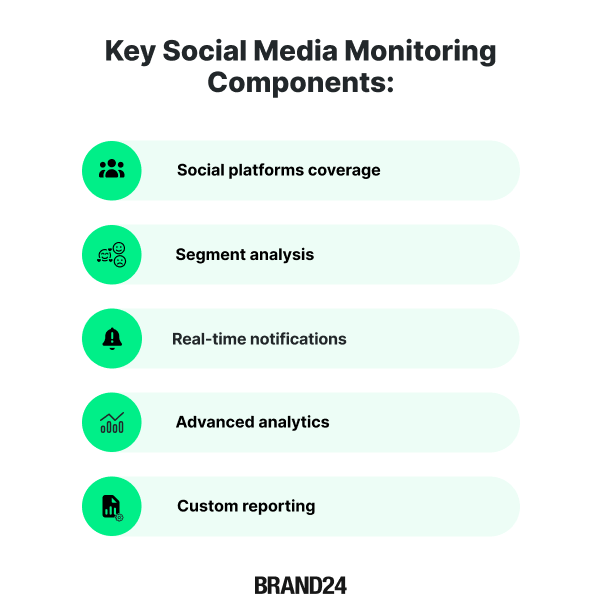
Social media monitoring strategy
Here are my top tips for setting up a successful social media monitoring project and gaining real value from it.
A strong social media monitoring strategy starts with a clear purpose, and then you need to pick the right tool. Use well-selected keywords to set up a monitoring project. Establish a routine with real-time listening, regular reviews, and reports, focusing on key metrics. Finally, integrate insights across your teams.
Step 1: Decide why you’re monitoring
First of all, you need to define your purpose. Why are you monitoring social media?
Start with a clear objective, which could be:
- Reputation management
- Campaign performance tracking
- Crisis detection or prevention
- Competitor benchmarking
- Customer insights
- Influencer identification
- Product feedback
Can you use it for all of the above?
Of course, you can use social monitoring data for much more than that!
This is just a reminder that it’s a good idea to have a plan (maybe several plans, one for each different use), or you may find yourself getting overwhelmed and confused by all the data.
Step 2: Choose the right tool
There are many social monitoring solutions on the market. My recommendation is to choose the one that best fits your needs and budget.
What are the most crucial features of a solid social media monitoring tool?
- Real-time monitoring
- Multi-platform coverage
- Sentiment analysis
- Topic analysis
- Reach & engagement metrics
- Influencer identification
- Share of voice (SOV)
- Event detector
- Automated reporting & alerts
- Advanced filters & boolean search
- Geo & demographic insights
- Competitor Comparison
- Historical Data
Make a list of must-have features and sources to track. Some social media monitoring platforms offer free trials. It’s a great way to test a tool’s full potential.
If you have any doubts, don’t hesitate to contact customer service and ask about the tool’s capabilities. They will help you with pleasure.
Step 3: Choose relevant keywords
Your monitoring is as good as your queries. That’s why it’s worth spending some time thinking about relevant keywords:
- Track your brand to capture all mentions, including those untagged:
- Your brand name, e.g., Lush, Lush Cosmetics
- Common misspellings or variations, e.g., Lusch, LushCos, lushh, Luscosmetics
- Your social media handles (without @), e.g., lushcosmetics, lush, lushpoland
- Product names or service names, e.g., Sleepy Lotion, Snow Fairy, Twilight Spray
- CEO name, e.g., Mark Constantine
- Track branded hashtags to measure campaign engagement and user-generated content.
- Campaign hashtags, e.g., #LushChristmas, #LushHalloween
- Event hashtags, e.g.,
- Community hashtags, e.g., #LushAddict, #LushieHaul
- Track competitors to enter insights into their strategy, sentiment, and share of voice:
- Brand names, e.g., The Body Shop, Bath & Body Works
- Product names or service names, e.g., Tea Tree Cleanser, Aromatherapy Sleep Lotion
- Campaign hashtags or slogans that they use, e.g.,
- Track industry and niche keywords to identify trends, emerging topics, and new business opportunities:
- Industry terms, e.g., natural skincare, clean beauty
- Problems your audience talks about, e.g., skin sensitivity, acne-prone, chemical-free alternatives
- Trends, e.g., skin cycling, zero-waste packaging
Important note: The more keywords you want to track, the more you usually need to pay. Most tools base their pricing on the number of monitored keywords.
How to get more relevant conversations in a monitoring project?
I have two powerful tips for you.
Pro Tip 1: Use required keywords
This is especially useful when you want to find out what people are saying about your company or product with respect to other companies and products.

Pro Tip 2: Use excluded keywords
This is especially useful when you see many mentions containing a keyword that disrupts the entire project.

I quickly entered Sleepy as an Excluded keyword in my Lush monitoring project. As a result, the tool will show me mentions of body lotions without mentioning Sleepy, one of Lush’s most popular body lotions.
Why is it helpful? Adding the required and excluded keywords makes your monitoring project more precise. This allows you to focus on the mentions and topics that matter most.
Step 4: Set up a social media monitoring process
So there you have it, a well-performing project based on the right keywords. What’s next? You need a routine.
Here’s an example of a well-defined social media monitoring strategy:
- Real-time listening: Set alerts for sudden spikes or negative mentions
- Daily/weekly reviews: Track ongoing campaigns and brand health
- Monthly/quarterly reports: Spot long-term trends and strategic insights
While checking your data, pay attention to the key social media monitoring metrics:
- Volume of mentions: Is brand buzz increasing?
- Reach: How far are conversations spreading?
- Sentiment: Are mentions positive or negative?
- Engagement: Are people interacting with your content or mentions?
- Sources: Which platforms are driving the most mentions?
- Share of Voice (SOV): Who dominates the market?
- Trending topics and hashtags: What are emerging trends and customer interests?
- Influencer Score: Who are the top authors, creators, and sites that mention your brand?
Step 5: Integrate with broader marketing strategy
Social media monitoring and analysis deliver powerful insights that can boost your marketing efforts in many ways. That’s why I recommend combining it across teams:
- Social media management: proactively respond to social media mentions to increase engagement, brand awareness, and customer loyalty significantly
- Customer support: track what customers are saying in real time and act on complaints instantly
- Marketing: refine content and campaigns based on feedback, analytics, and metrics
- PR: monitor customer sentiment, prepare responses to crises, or leverage positive buzz
- Partnership management: identify content creators already talking about your brand, which leads to potential influencer partnerships
- Product Teams prioritize fixes or new features based on customer feedback
Step 6: Monitor, take action, repeat
The most important part of social media monitoring is consistency. Consistently check-in. Consistently clean up your results. Consistently respond and react.
Monitoring social media platforms is automated, but you should be part of it.
Regularly:
- Answer to crucial mentions to boost your brand recognition
- Update keywords, queries, hashtags as the language evolves
- Refine filters to gain the most accurate data
- Benchmark against past performance and competitors
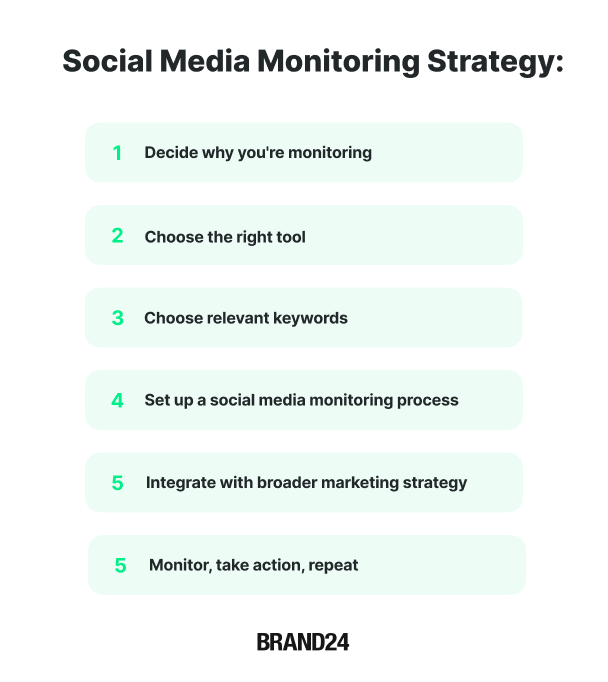
Top social media monitoring tools (list updated in October 2025)
There are a few tools for monitoring social media worth checking. Here is a detailed comparison: The Best Social Media Monitoring Tools. Most of them offer a free trial period, which gives you a couple of days to play with the tool.
Now, let’s quickly check the top 3 tools worth your attention:
| Brand24 | Sprout Social | Hootsuite | |
| Overview | AI-driven social media monitoring and analytics tool | All-in-one social media management suite offering social listening | Long-standing social media management platform offering monitoring |
| Monitored sources | Instagram, X (Twitter), Facebook, Reddit, LinkedIn, Quora, YouTube, TikTok, Telegram, Twitch, Pinterest, Bluesky | Facebook, Instagram, Reddit, TikTok, Tumblr, X (Twitter), YouTube | Facebook, Instagram, TikTok, Threads, X (Twitter), Bluesky, LinkedIn, YouTube, Pinterest, Reddit |
| Best for | Agencies, Mid-sized businesses, enterprises | Mid-sized businesses and enterprises | Large agencies and enterprises |
| G2 review rating | 4.6 | 4.4 | 4.3 |
| Starting price | Individual plan starts at $149 | Social listening is offered as an optional add-on, pricing starts at $999 per month | Basic monitoring starts at $99, advanced social listening is offered as an add-on in custom plan |
I have been tracking the key tools for social media monitoring for quite some time. I use Brand24 for this purpose, which provides me with valuable insights.
Let’s unvocer them.
Here you can see the comparison of the online performance of Brand24, Sprout Social, and Hootsuite:
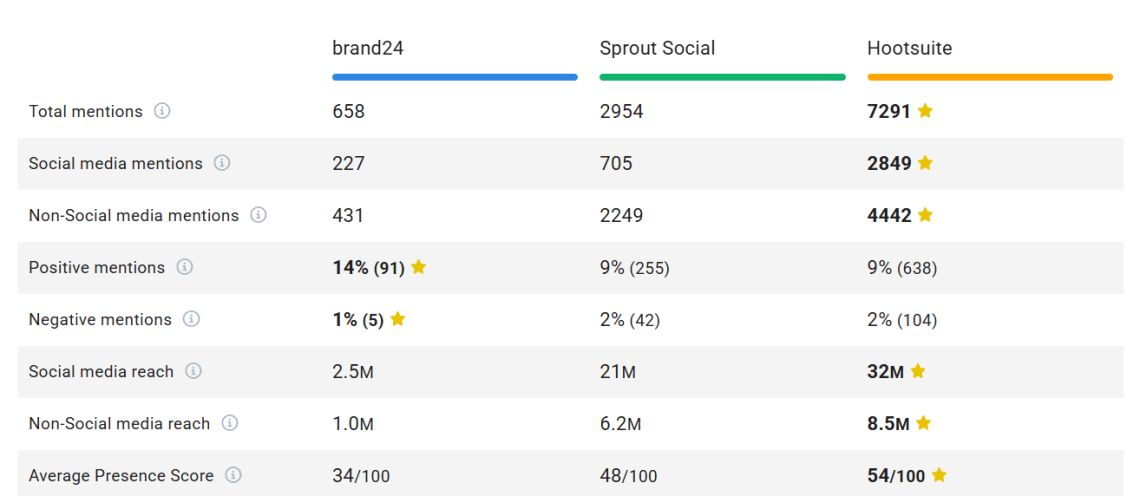
Hootsuite is undoubtedly the most popular tool, gaining the largest number of online brand mentions. Sprout Social is also a well-known tool in the marketing industry. Brand24 is less popular, but it has the most positive sentiment.
I also asked the AI Brand Assistant about the key strengths and features that users mentioned online. Here’s a list:
Brand24:
- Strong in real-time monitoring and AI features
- Particularly effective brand monitoring and sentiment tracking
- Praised for affordability and effectiveness for businesses of all sizes
Sprout Social:
- Known for comprehensive social media management
- Strong analytics and engagement tracking features
- Popular among enterprise clients
Hootsuite:
- Strong in multi-platform management
- Popular for advanced scheduling and content management
- Some users report pricing concerns
How important is AI social media monitoring in the second half of 2025?
According to Pluggo research, in 2025, the global social listening market is projected to reach USD 10.32 billion, with 62% of marketers already actively using these tools.
AI social media monitoring helps you achieve your goals more quickly. AI analyzes the monitored data and provides you with real-time, actionable insights.
Let’s take a closer look at how AI can enrich social media monitoring features:
Smarter sentiment analysis
AI-powered sentiment analysis is far more advanced than traditional methods. It goes beyond “positive/negative/neutral”. It can detect specific emotions.
Advantages of using AI sentiment analysis:
- Detects sarcasm, irony, and cultural nuances.
- Understands emojis, hashtags, and slang
- Identifies emerging topics driving sentiment shifts.
- Provides real-time insights with visual dashboards and alerts.
- Can explain why sentiment changed
Built-in AI chat (just like ChatGPT)
Top tools offer AI-powered chat that you can use to talk about your monitoring data. It works like ChatGPT but is driven by your monitoring project data.
All you need to do is ask questions, for example:
- What are my competitors’ weaknesses?
- Which influencers drive the most reach for us?
- What caused our negative sentiment last week?
- What’s the performance on Instagram?
The chat will provide you with a comprehensive answer. You don’t have to dig into data. Social media tracking has never been easier.
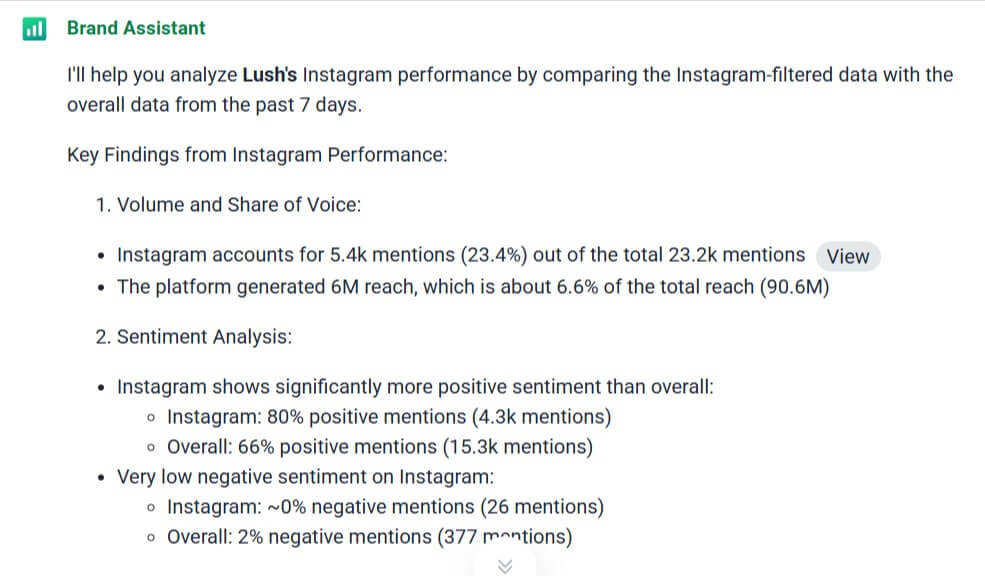
Ready to use AI insights
AI Insights are essentially automated, AI-powered summaries and recommendations based on your brand’s online conversations.
Instead of showing only raw data (charts, mentions, numbers), AI Insights interprets what’s happening and tells you what actions to take.
How does it work?
- AI analyzes your mentions, sentiment, reach, and topics using NLP and machine learning.
- Then it translates data into clear, actionable takeaways.
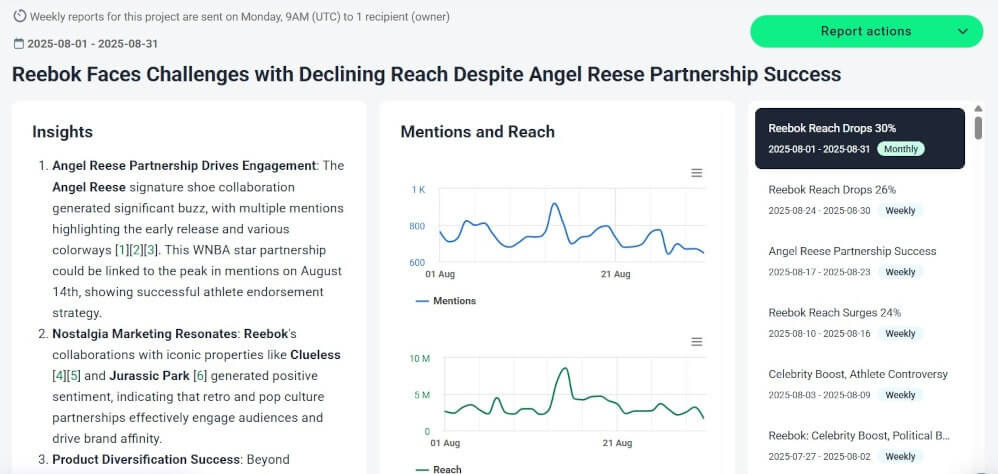
Real-time anomaly detection
AI anomaly detection (also called event detection) acts like an early warning. It tells you that something happened and explains why.
How does it work?
- When there’s a sudden spike (e.g., a viral tweet, negative press, or influencer shout-out), the AI immediately detects it.
- Instead of just showing numbers, it explains the cause of the anomaly in 2–3 sentences.
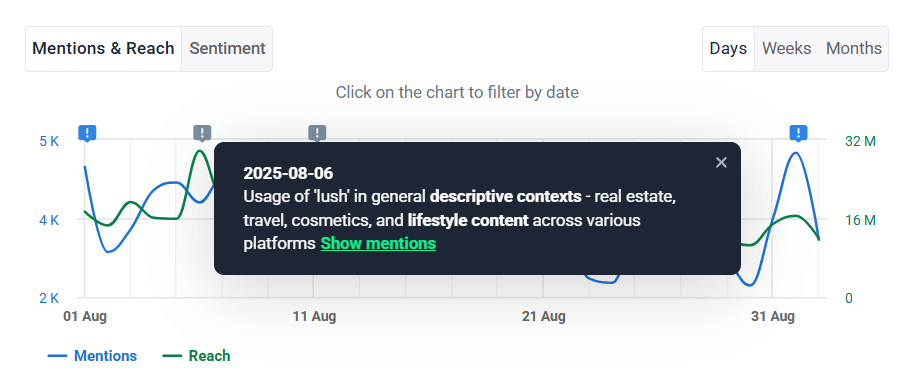
Advanced topics discovery and analytics
AI helps you understand what people are really talking about. Instead of just giving you raw mentions, Topic Analysis automatically clusters conversations into themes so you can see the bigger picture.
How does it work?
- It groups online mentions into discussion categories (e.g., product quality, pricing, customer service, influencers).
- Uses AI and Natural Language Processing (NLP) to detect context.
- Shows you which topics dominate the conversation and how much reach or engagement they generate.
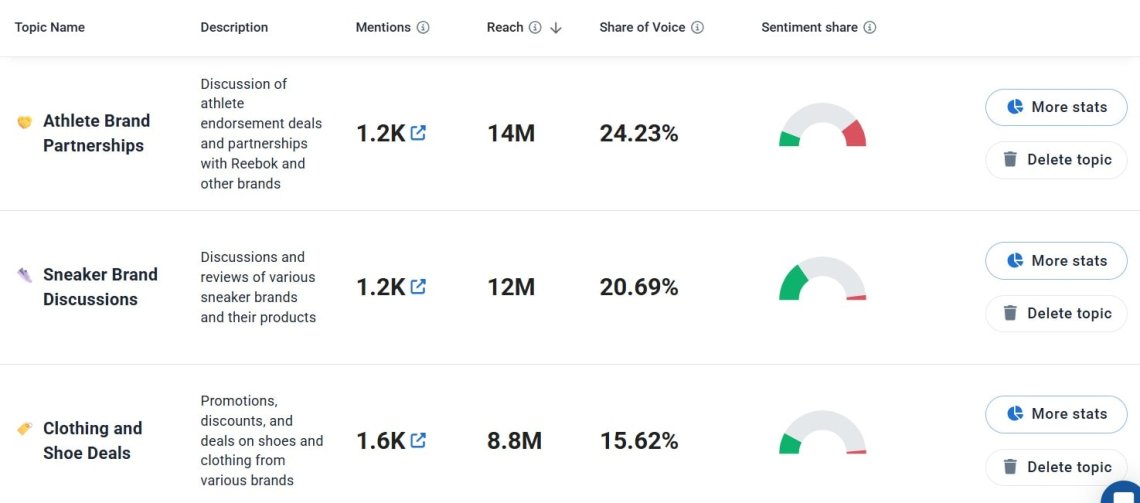
The future of social media monitoring 2025/2026
So, what can we expect in 2025 and 2026?
I’ve asked this question to Michał Sadowki and Karol Kłaczyński, who play a vital role in developing Brand24 media monitoring software.
Here are their key thoughts:
Monitoring will be a fuel for AI Visibility & LLM SEO:
- In 2025, social monitoring will be integrated into AI visibility strategies, helping marketers identify and activate high-impact conversations that shape algorithmic brand understanding.
The demand for simplicity:
- Many users don’t want to spend hours learning new, complex tools.
- Chat-based interfaces (like ChatGPT) will increasingly replace traditional dashboards.
Users expect ready-to-use insights:
- Tools must provide insights in a natural, intuitive way.
- The focus will shift from raw data to delivering the essence of insights quickly.
The end of Boolean Searches:
- Boolean searches will likely disappear within the next few years.
- Users will expect accurate results without needing technical expertise.
Integration with AI Assistants
- With the rise of Multi-Channel Plugins (MCPs) and API connections between tools like Brand24 and LLMs, real-time querying of social listening data through chat interfaces will expand rapidly.
- By mid-2026, Forrester predicts that over 40% of enterprise users will rely on LLMs to access third-party social data.
Key thoughts
On average, a person uses about 6.8 different social networks each month. The average daily time spent on social media is approximately 2 hours and 20 to 24 minutes.
These days, the volume of social media posts generated each day is enormous.
Your brand can be mentioned everywhere. That’s why, while using social media monitoring, remember to:
- Check your monitoring projects regularly
- Filter the noise and focus on key mentions
- Pay attention to the sentiment
- Track the performance of your competitors
- Set up alerts and automated reports



